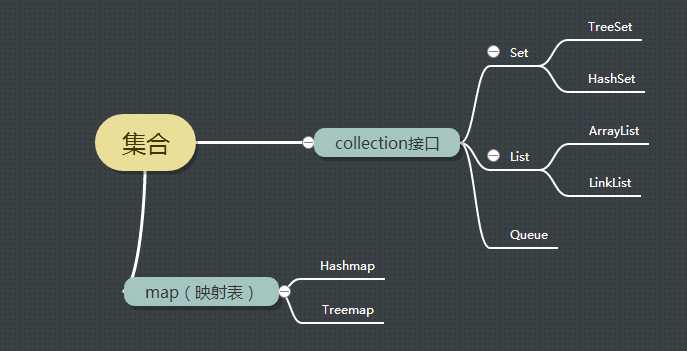201521123088《Java程序设计》第七周学习总结
Posted
tags:
篇首语:本文由小常识网(cha138.com)小编为大家整理,主要介绍了201521123088《Java程序设计》第七周学习总结相关的知识,希望对你有一定的参考价值。
1. 本周学习总结
以你喜欢的方式(思维导图或其他)归纳总结集合相关内容。
2. 书面作业
ArrayList代码分析
1.1 解释ArrayList的contains源代码
源代码:
//contains()方法 public boolean contains(Object o) { return indexOf(o) >= 0; } //indexOf()方法 public int indexOf(Object o) { if (o == null) { for (int i = 0; i < size; i++) if (elementData[i]==null) return i; } else { for (int i = 0; i < size; i++) if (o.equals(elementData[i])) return i; } return -1; }
答:在indexOf()方法中对传进来的值o判断是否为null,因为值o若为null,则不可以使用equals进行比较。如果找到了值o,则返回对应的数组下标;如果满意找到,则返回-1,那么contains()方法就会返回false。1.2 解释E remove(int index)源代码
//remove代码 public E remove(int index) { rangeCheck(index); modCount++; E oldValue = elementData(index); int numMoved = size - index - 1; if (numMoved > 0) System.arraycopy(elementData, index+1, elementData, index, numMoved); elementData[--size] = null; // clear to let GC do its work return oldValue; } //rangeCheck代码 private void rangeCheck(int index) { if (index >= size) throw new IndexOutOfBoundsException(outOfBoundsMsg(index)); }
答:首先在remove()方法中调用rangeCheck()方法,是用来判断传入的index是否超过size,若超过,则抛出IndexOutOfBoundsException异常。然后这个remove()方法就是将对应下标的元素取出,再将后面的元素全部往前移一位,将最后一位,即size-1的位置置null。1.3 结合1.1与1.2,回答ArrayList存储数据时需要考虑元素的类型吗?
答:不需要。从1.1和1.2的源代码中可以看到其传入的对象是object,Object为一个顶级父类,它是任何类父类,所以说ArrayList存储数据时不用考虑元素类型。
1.4 分析add源代码,回答当内部数组容量不够时,怎么办?
源代码:
//add代码 public boolean add(E e) { ensureCapacityInternal(size + 1); elementData[size++] = e; return true; //ensureCapacityInternal代码 private void ensureCapacityInternal(int minCapacity) { if (elementData == DEFAULTCAPACITY_EMPTY_ELEMENTDATA) { minCapacity = Math.max(DEFAULT_CAPACITY, minCapacity); } ensureExplicitCapacity(minCapacity); } modCount++; // overflow-conscious code if (minCapacity - elementData.length > 0) grow(minCapacity); } } //grow代码 private void grow(int minCapacity) { // overflow-conscious code int oldCapacity = elementData.length; int newCapacity = oldCapacity + (oldCapacity >> 1); if (newCapacity - minCapacity < 0) newCapacity = minCapacity; if (newCapacity - MAX_ARRAY_SIZE > 0) newCapacity = hugeCapacity(minCapacity); // minCapacity is usually close to size, so this is a win: elementData = Arrays.copyOf(elementData, newCapacity); }
答:当内部数组容量不够时,首先ensureCapacityInternal方法得到最小扩容量,其次ensureExplicitCapacity判断是否要扩容。1.5 分析private void rangeCheck(int index)源代码,为什么该方法应该声明为private而不声明为public?
private void rangeCheck(int index) { if (index >= size) throw new IndexOutOfBoundsException(outOfBoundsMsg(index)); }
答:因为rangeCheck()方法只需要判断数组是否越界,没有其他的作用,外部不需要对它进行修改或者访问,所以说声明应为private。HashSet原理
2.1 将元素加入HashSet(散列集)中,其存储位置如何确定?需要调用那些方法?
答:计算出带存储的散列码作为存储的位置依据,将对象存入Hash类集合
要调用equals和hashCode方法
ArrayListIntegerStack
题集jmu-Java-05-集合之5-1 ArrayListIntegerStack
3.1 比较自己写的ArrayListIntegerStack与自己在题集jmu-Java-04-面向对象2-进阶-多态、接口与内部类中的题目5-3自定义接口ArrayIntegerStack,有什么不同?(不要出现大段代码)
private ArrayList<Integer> list; public ArrayListIntegerStack(){ list=new ArrayList<Integer>();//使用了Arraylist } public Integer push(Integer item) { // TODO Auto-generated method stub if(item==null) return null; list.add(item);//用到了add方法 return item; } public Integer pop() { // TODO Auto-generated method stub if(list.size()==0) return null; return list.remove(list.size()-1);//用到remove方法 }
04-5-3中的ArrayListIntegerStack
private Integer[]arr;//使用数组
private int top=0;//top指针 public ArrayIntegerStack(int capacity) { arr=new Integer[capacity]; } public Integer pop(){ if(top==0) return null; top--;//出栈需要移动指针 return arr[top]; }
答:在5-1中编写的ArrayListIntegerStack使用的是ArrayList数组来存放对象,因此相应的push、pop、peek等方法的编写用到了list中的add、remove等方法;5-3中则是用数组来存放对象,并且要有top指针。
3.2 简单描述接口的好处.
答:根本区别就是一个内部使用数组实现,一个内部使用ArrayList实现,数组的话增删查改都要自己编写方法,ArrayList可以调用已有方法进行操作。
Stack and Queue
4.1 编写函数判断一个给定字符串是否是回文,一定要使用栈,但不能使用java的Stack类(具体原因自己搜索)。请粘贴你的代码,类名为Main你的学号。
public class Main201521123088 { public static void main(String[] args) { // TODO Auto-generated method stub Scanner sc=new Scanner(System.in); String x=sc.next(); ArrayListStringStack list=new ArrayListStringStack(); ArrayListStringStack list1=new ArrayListStringStack(); char [] arr = x.toCharArray(); for(int i=0;i<arr.length;i++){ list.push(String.valueOf(arr[i])); } int q=arr.length/2; int k=arr.length%2; if(k==0){ for(int y=1;y<=q;y++){ list1.push(list.pop()); } for(int b=0;!list.empty()&&!list1.empty();b++){ if(!list.pop().equals(list1.pop())){ System.out.println("该字符串不是回文"); break; } if(list.empty()&&list1.empty()){ System.out.println("该字符串是回文"); } } } else{ for(int p=1;p<=q;p++){ list1.push(list.pop()); } list.pop(); for(int b=0;!list.empty()&&!list1.empty();b++){ if(!(list.pop().equals(list1.pop()))){ System.out.println("该字符串不是回文"); break; } if(list.empty()&&list1.empty()){ System.out.println("该字符串是回文"); break; } } } } }
运行结果:



4.2 题集jmu-Java-05-集合之5-6 银行业务队列简单模拟。(不要出现大段代码)
for (int i = 0; i < n; i++) { int number = in.nextInt(); if (number % 2 == 0) B.add(number); else A.add(number); } while(!A.isEmpty() || !B.isEmpty()) { Integer a1 = A.poll(); if(a1 != null){ if(B.isEmpty() && A.isEmpty()) System.out.print(a1); else System.out.print(a1 + " "); } Integer a2 = A.poll(); if(a2 != null){ if(B.isEmpty() && A.isEmpty()) System.out.print(a2); else System.out.print(a2 + " "); } Integer b = B.poll(); if(b != null){ if(B.isEmpty() && A.isEmpty()) System.out.print(b); else System.out.print(b + " "); } }
题集jmu-Java-05-集合之5-2 统计文字中的单词数量并按单词的字母顺序排序后输出 (不要出现大段代码)
5.1 实验总结
答:用TreeSet的add方法将指定的元素添加到此 set(如果该元素尚未存在于 set 中)。更确切地讲,如果该 set 不包含满足 (e==null ? e2==null : e.equals(e2)) 的元素 e2,则将指定元素 e 添加到此 set 中。如果此 set 已经包含这样的元素,则该调用不改变此 set 并返回 false。且就会默认帮我们排好序,最后按要求输出一下即可。
面向对象设计大作业-改进
7.1 完善图形界面(说明与上次作业相比增加与修改了些什么)
7.2 使用集合类改进大作业
3. 码云上代码提交记录及PTA实验总结
题目集:jmu-Java-05-集合
3.1. 码云代码提交记录
在码云的项目中,依次选择“统计-Commits历史-设置时间段”, 然后搜索并截图
以上是关于201521123088《Java程序设计》第七周学习总结的主要内容,如果未能解决你的问题,请参考以下文章